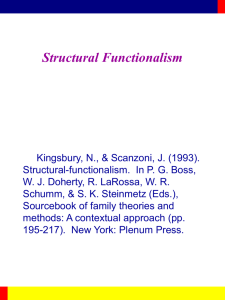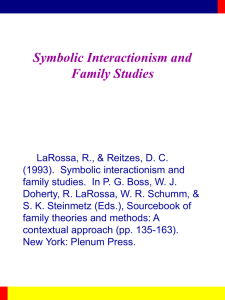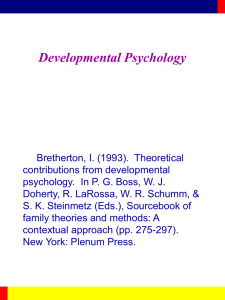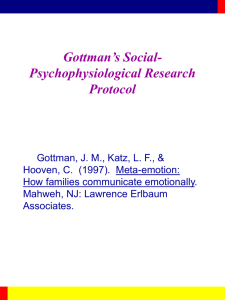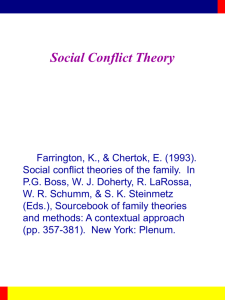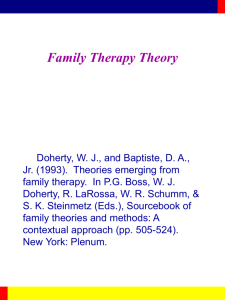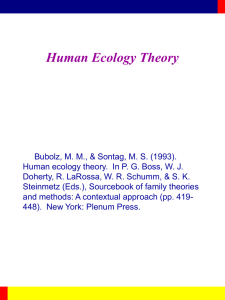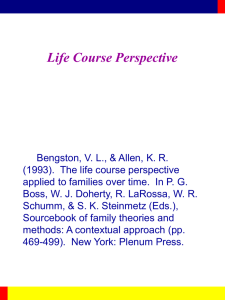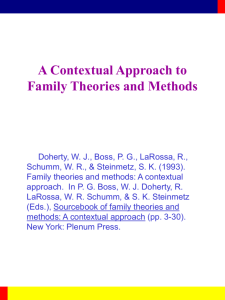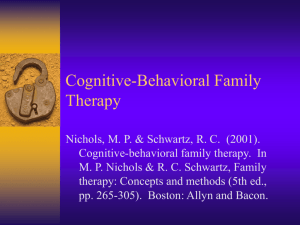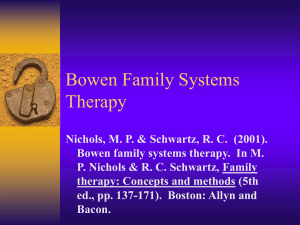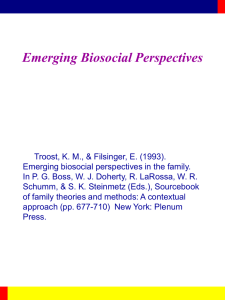Communication Theory and The Family
advertisement
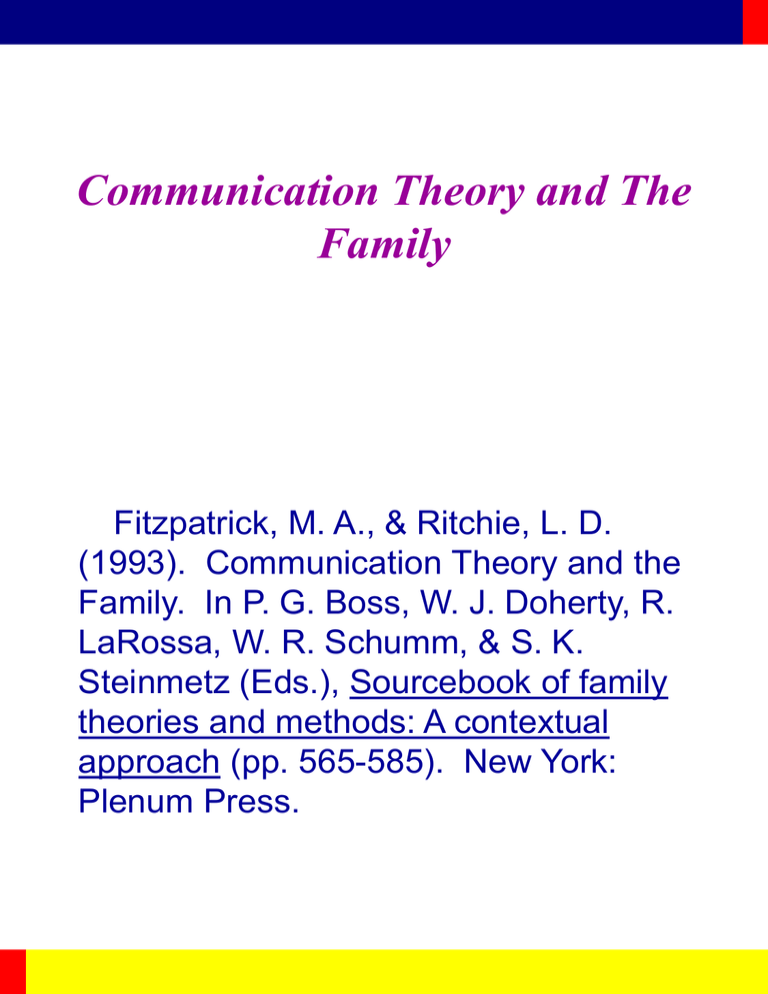
Communication Theory and The Family Fitzpatrick, M. A., & Ritchie, L. D. (1993). Communication Theory and the Family. In P. G. Boss, W. J. Doherty, R. LaRossa, W. R. Schumm, & S. K. Steinmetz (Eds.), Sourcebook of family theories and methods: A contextual approach (pp. 565-585). New York: Plenum Press. The Academic Discipline of Communication Develop testable hypotheses in order to understand the production, processing, and effects of symbol and signal systems. It focuses on one category of behavior -communication -- across many levels of analysis. There are various distinctions (e.g., mass communication versus interpersonal, applied versus theoretical). Dr. Ronald J. Werner-Wilson Mass Communication Research Early theoretical interests: propaganda and persuasion; free expression and regulation; political participation; influence of technology. Influence on discipline: Increased popularity of television. Fear about unethical persuasion techniques. Research on families compared the influence of families to the influence of television. Dr. Ronald J. Werner-Wilson Interpersonal Communication Research Early research focused on characteristics of speakers, seeking to understand variables associated with persuasiveness. Contemporary research examines factors which influence interpersonal communication. Dr. Ronald J. Werner-Wilson Terms Definition of Human Communication Dimensions of communication: Symbols: something that can be used to represent something else. The medium for transmitting symbols. Cognitive processes which influence transmission and interpretation of symbols. Social norms which govern meaning. Two Key Communication Constructs Intersubjectivity: sharing of cognitions in a communicative event. There are three ways intersubjectivity may affect communication: Communication may require a shared set of meanings. Communication may occur in the context of shared relationship norms. Communication may lead to a shared set of ideas about the environment. Interactivity: the degree to which symbol creation and interpretation are linked. This requires encoding by the sender and decoding by the receiver(s). Dr. Ronald J. Werner-Wilson Code Model I: The Strong Code Model Communication is linear. Words and meanings are mapped in a simple one-to-one correspondence with “meanings.” A dictionary is a “codebook.” Communication failure is attributed to incompetent coding, incompetent decoding, or degradation of the signal (a/k/a/ “noise”). Implication of this model: limited opportunity to distinguish family communication from other forms. Dr. Ronald J. Werner-Wilson Code Model II: The Weak Code Model Early computer translation experiments discovered that natural language is ambiguous and nonlinear. This refined model was more elaborate; it recognized that each symbol can have multiple meanings. A decoder is responsible for interpreting the meaning of the message. Implication of this model: limited opportunity to distinguish family communication from other forms. Dr. Ronald J. Werner-Wilson The Inferential Model Fundamental assumption: many, if not most, symbols are ambiguous. Communicative act requires the speaker to direct attention toward facts from which certain inferences are likely to be drawn. Communication occurs when one person produces some representation of their thoughts, and anther person constructs a mental representation of that representation. Comprehension is dependent on knowledge of goals and plans of participants in the interaction. We supply information from our knowledge. Implication of this model: opportunity to develop unique theories of family communication which requires that we account for the influence of distinguishing family features on family members’ expectations; structure of relevancies within the family; and how family context shapes perception. Dr. Ronald J. Werner-Wilson Metaphor 1: The Family is a Private Miniculture Family culture is created and sustained through communication. Emphasizes knowledge, ideology, rules, values, and day-to-day rituals. Although families are private cultures, it is still possible to identify predictable patterns in families. Influenced by symbolic interactionism. The relational typology (see FITZ2&3.DOC for a typology and research about marital satisfaction): Measures relational (e.g., traditionalism) and information exchange aspects of communication (e.g., sharing, and conflict avoidance). Most research has been conducted with couples residing in the same house, although limited research has been conducted on cohabiting heterosexual and homosexual couples. Dr. Ronald J. Werner-Wilson Metaphor 1: The Family is a Private Miniculture (cont.) Family communication patterns: Examines the influence of communication on shared understanding between family members. Research often emphasizes the influence of family structure on communication. Accuracy: match between impression of one person and the thoughts of another. Congruency: first person presumes that the second person thinks in a compatible way. Dr. Ronald J. Werner-Wilson Metaphor 1: The Family is a Private Miniculture (cont.) The Family as an information-processing group (exemplified by Reiss, 1981): Focuses on entire family rather than on a dyad within the family. Families are classified according to the effects of observed behavior of the family on individuals’ behavior. Central theoretical proposition: families develop fundamental and enduring assumptions about the world based on it’s own development. Families develop constructs. Paradigm change occurs because of crisis. Family structure is generated and sustained in the daily interactions among family members. Dr. Ronald J. Werner-Wilson Metaphor 2: The Family is a Resource Exchange System Assumption: family members exchange resources (e.g., time, expertise); exchanges are guided by the desire to maximize rewards and minimize costs. Family scientists, using exchange theory, focus on the resources; communication scientists, in contrast, focus on communication as the means for exchanging, communication as a resource to be exchanged. Dr. Ronald J. Werner-Wilson Metaphor 2: The Family is a Res. Exchange System (cont.) Coercive family process theory Problematic interactional patterns between parents and children may cause antisocial and aggressive behavior in children. There are five major forms: Family members are generally critical and punitive. Parents are poor observers of their child’s behavior so deviant behavior reaches unmanageable proportions. Punishment is used in an inconsistent manner. Parents display lower levels of positive contact and are less likely to use positive reinforcement. Rewards are used coercively. Dr. Ronald J. Werner-Wilson Metaphor 2: The Family is a Res. Exchange System (cont.) Social learning models of marital interaction Assumptions: people only enter and stay in relationships that are equitable. Positive interaction is associated with relationships satisfaction. John Gottman, for example, has demonstrated that couples with at least a 5:1 ration of positive to negative interactions are less likely to divorce. See also Fitzpatrick, 1988; Ting-Toomey, 1983; Schaap, 1984; Gottman, 1979, 1995; Jacobson et al., 1982; Margolin and Wampold, 1981; and Revenstorf et al., 1984). Dr. Ronald J. Werner-Wilson Metaphor 3: The Family is a set of Relationships Subsystems are the focus of research and theory. Relationship: conceptualized as a series of interactions between individuals Each interactions is limited in duration. Each interaction is influenced by previous interactions. This approach has had a strong influence on family systems theory and research. Dr. Ronald J. Werner-Wilson Metaphor 3: The Family is a set of Relationships (cont.) Relational control model Messages are bimodal, featuring two levels: Content level: what was said. Report level: what is meant or interpreted. Messages are interconnected. Patterns of interaction: Complementary: two messages are paired which are “opposite” or compatible forms (e.g., a dominant message with a submissive responsive). Example: messages to assert control is paired with a message that relinquishes control. Symmetrical: two messages have similar intent. Example: both speakers seek to assert control. Dr. Ronald J. Werner-Wilson
